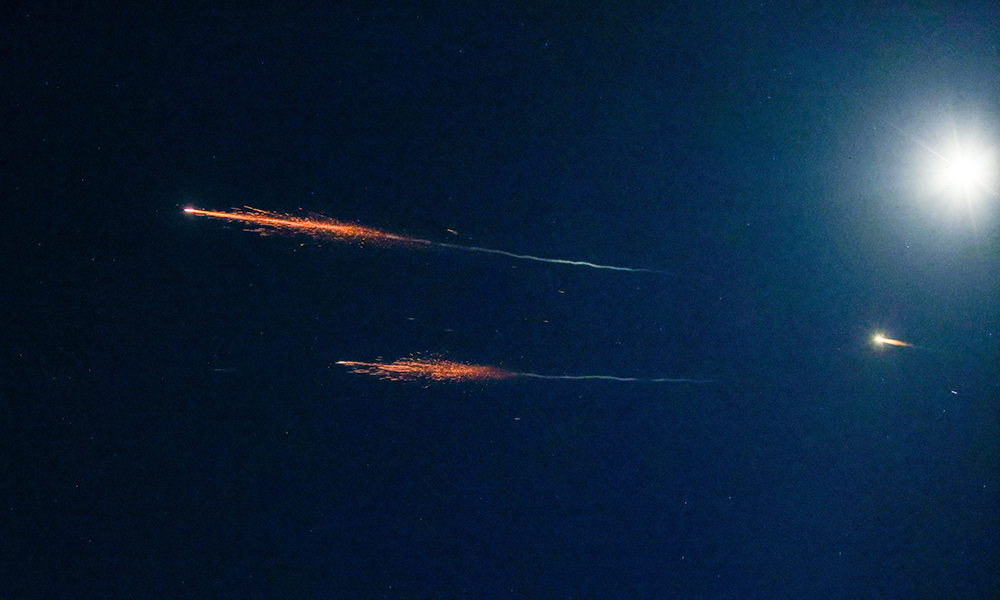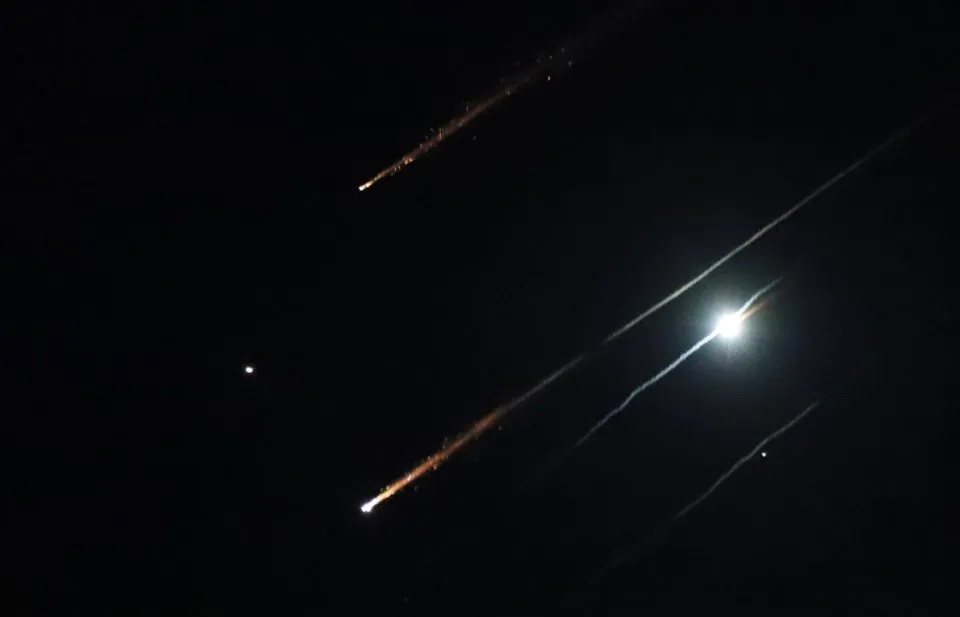
? 作為對以色列大規(guī)模空襲的回應(yīng),,伊朗已向以方發(fā)射數(shù)百枚導(dǎo)彈,,但數(shù)量未達(dá)預(yù)期。與此同時,,以色列已針對伊朗導(dǎo)彈及其發(fā)射能力展開打擊,。戰(zhàn)爭研究所(Institute for the Study of War)指出,伊朗的攻擊頻次相較于初期密集轟炸階段已有所放緩,。
隨著雙方似乎都在擴(kuò)大打擊目標(biāo)范圍(包括能源基礎(chǔ)設(shè)施),,以伊沖突在上周末進(jìn)一步升級。
然而,,盡管以色列發(fā)動猛烈空襲,,甚至有跡象表明其目標(biāo)直指伊朗政權(quán),伊朗卻并未以同等規(guī)?;?fù)簟獙?dǎo)彈發(fā)射量低于預(yù)期且頻次持續(xù)下降,。
戰(zhàn)爭研究所指出,這是因?yàn)橐陨幸褜⒁晾实膶?dǎo)彈儲備及其發(fā)射能力作為打擊目標(biāo),。
戰(zhàn)爭研究所研究人員在上周日發(fā)布的一份評估報告中寫道:“自6月12日以色列發(fā)動空襲以來,,伊朗針對以色列的導(dǎo)彈襲擊頻次已有所下降,這表明以色列的打擊行動正對伊朗向以色列發(fā)射導(dǎo)彈的速率產(chǎn)生影響,?!?
據(jù)該研究所估算,上周五至周六期間,,伊朗發(fā)起了六輪攻擊,,動用了100至200枚導(dǎo)彈。但自上周六起,,伊朗僅發(fā)動兩輪攻擊,,每輪使用35至40枚導(dǎo)彈。
按戰(zhàn)爭研究所估算的上限來看,,初期每輪平均約33枚導(dǎo)彈,,而后續(xù)每輪平均僅20枚,。
上周六,戰(zhàn)爭研究所對以伊沖突的分析指出,,據(jù)報道伊朗原計劃向以色列發(fā)射1000枚彈道導(dǎo)彈以回應(yīng)以方襲擊,,但該研究所當(dāng)時統(tǒng)計的數(shù)據(jù)顯示,實(shí)際發(fā)射總量僅為200枚,。
戰(zhàn)爭研究所寫道:“伊朗對以色列反擊所動用的彈藥數(shù)量遠(yuǎn)低于最初計劃,,原因是以色列國防軍摧毀并破壞了伊朗原計劃用于報復(fù)以色列的導(dǎo)彈發(fā)射架和發(fā)射井?!?/p>
根據(jù)戰(zhàn)爭研究所的數(shù)據(jù),,在當(dāng)前沖突爆發(fā)前,美國和以色列估算伊朗的導(dǎo)彈庫存量約為2000枚,,不過并非所有導(dǎo)彈都具備抵達(dá)以色列的射程,。
若這一預(yù)估數(shù)字無誤,那么伊朗目前針對以色列的導(dǎo)彈發(fā)射速率或許難以長久維持,。

誠然,,伊朗造成了重大損失并致人員傷亡,,但以色列的“鐵穹”導(dǎo)彈防御系統(tǒng)成功攔截諸多襲擊,限制了伊朗報復(fù)行動的成效,。
其他分析人士此前曾指出,,伊朗可行的軍事選項(xiàng)有限,其整體能力已被以色列嚴(yán)重削弱,。
這可能迫使伊朗尋求不依賴導(dǎo)彈發(fā)射的報復(fù)方式,。上周六,一名伊朗議員稱,,封鎖霍爾木茲海峽這一全球能源貿(mào)易的關(guān)鍵咽喉要道正在認(rèn)真考慮之中,。該海峽每日輸送的石油量約占全球石油液體消費(fèi)量的21%,約為2100萬桶,。
與此同時,以色列持續(xù)推進(jìn)空襲行動,,并將打擊目標(biāo)拓展至伊朗能源基礎(chǔ)設(shè)施,。在消滅伊朗大部分高級軍事領(lǐng)導(dǎo)層,并對核設(shè)施和軍事設(shè)施進(jìn)行猛烈轟炸之后,,以色列又對燃料供應(yīng)設(shè)施以及素有全球最大天然氣田之稱的南帕爾斯氣田發(fā)起襲擊,。
根據(jù)戰(zhàn)爭研究所的數(shù)據(jù),帕爾斯氣田對伊朗國內(nèi)能源生產(chǎn)至關(guān)重要,,伊朗90%以上的電力由燃?xì)怆姀S供應(yīng),。
“伊朗天然氣生產(chǎn)中斷可能會加劇該國持續(xù)的能源危機(jī),,進(jìn)而引發(fā)更廣泛的電力中斷,”戰(zhàn)爭研究所上周日指出,?!按饲耙晾拭癖娫蚰茉炊倘倍鴮φ?quán)發(fā)起抗議。2017年和2018年天然氣價格上漲引發(fā)的示威活動升級為對政權(quán)穩(wěn)定的更廣泛挑戰(zhàn),?!保ㄘ敻恢形木W(wǎng))
譯者:中慧言-王芳
? 作為對以色列大規(guī)模空襲的回應(yīng),,伊朗已向以方發(fā)射數(shù)百枚導(dǎo)彈,,但數(shù)量未達(dá)預(yù)期。與此同時,,以色列已針對伊朗導(dǎo)彈及其發(fā)射能力展開打擊,。戰(zhàn)爭研究所(Institute for the Study of War)指出,伊朗的攻擊頻次相較于初期密集轟炸階段已有所放緩,。
隨著雙方似乎都在擴(kuò)大打擊目標(biāo)范圍(包括能源基礎(chǔ)設(shè)施),,以伊沖突在上周末進(jìn)一步升級。
然而,,盡管以色列發(fā)動猛烈空襲,,甚至有跡象表明其目標(biāo)直指伊朗政權(quán),伊朗卻并未以同等規(guī)?;?fù)簟獙?dǎo)彈發(fā)射量低于預(yù)期且頻次持續(xù)下降,。
戰(zhàn)爭研究所指出,這是因?yàn)橐陨幸褜⒁晾实膶?dǎo)彈儲備及其發(fā)射能力作為打擊目標(biāo),。
戰(zhàn)爭研究所研究人員在上周日發(fā)布的一份評估報告中寫道:“自6月12日以色列發(fā)動空襲以來,,伊朗針對以色列的導(dǎo)彈襲擊頻次已有所下降,這表明以色列的打擊行動正對伊朗向以色列發(fā)射導(dǎo)彈的速率產(chǎn)生影響,?!?
據(jù)該研究所估算,上周五至周六期間,,伊朗發(fā)起了六輪攻擊,,動用了100至200枚導(dǎo)彈。但自上周六起,,伊朗僅發(fā)動兩輪攻擊,,每輪使用35至40枚導(dǎo)彈。
按戰(zhàn)爭研究所估算的上限來看,,初期每輪平均約33枚導(dǎo)彈,,而后續(xù)每輪平均僅20枚。
上周六,,戰(zhàn)爭研究所對以伊沖突的分析指出,,據(jù)報道伊朗原計劃向以色列發(fā)射1000枚彈道導(dǎo)彈以回應(yīng)以方襲擊,,但該研究所當(dāng)時統(tǒng)計的數(shù)據(jù)顯示,實(shí)際發(fā)射總量僅為200枚,。
戰(zhàn)爭研究所寫道:“伊朗對以色列反擊所動用的彈藥數(shù)量遠(yuǎn)低于最初計劃,,原因是以色列國防軍摧毀并破壞了伊朗原計劃用于報復(fù)以色列的導(dǎo)彈發(fā)射架和發(fā)射井?!?/p>
根據(jù)戰(zhàn)爭研究所的數(shù)據(jù),,在當(dāng)前沖突爆發(fā)前,美國和以色列估算伊朗的導(dǎo)彈庫存量約為2000枚,,不過并非所有導(dǎo)彈都具備抵達(dá)以色列的射程,。
若這一預(yù)估數(shù)字無誤,那么伊朗目前針對以色列的導(dǎo)彈發(fā)射速率或許難以長久維持,。
誠然,,伊朗造成了重大損失并致人員傷亡,但以色列的“鐵穹”導(dǎo)彈防御系統(tǒng)成功攔截諸多襲擊,,限制了伊朗報復(fù)行動的成效,。
其他分析人士此前曾指出,伊朗可行的軍事選項(xiàng)有限,,其整體能力已被以色列嚴(yán)重削弱,。
這可能迫使伊朗尋求不依賴導(dǎo)彈發(fā)射的報復(fù)方式。上周六,,一名伊朗議員稱,,封鎖霍爾木茲海峽這一全球能源貿(mào)易的關(guān)鍵咽喉要道正在認(rèn)真考慮之中。該海峽每日輸送的石油量約占全球石油液體消費(fèi)量的21%,,約為2100萬桶,。
與此同時,以色列持續(xù)推進(jìn)空襲行動,,并將打擊目標(biāo)拓展至伊朗能源基礎(chǔ)設(shè)施,。在消滅伊朗大部分高級軍事領(lǐng)導(dǎo)層,并對核設(shè)施和軍事設(shè)施進(jìn)行猛烈轟炸之后,,以色列又對燃料供應(yīng)設(shè)施以及素有全球最大天然氣田之稱的南帕爾斯氣田發(fā)起襲擊,。
根據(jù)戰(zhàn)爭研究所的數(shù)據(jù),帕爾斯氣田對伊朗國內(nèi)能源生產(chǎn)至關(guān)重要,,伊朗90%以上的電力由燃?xì)怆姀S供應(yīng),。
“伊朗天然氣生產(chǎn)中斷可能會加劇該國持續(xù)的能源危機(jī),進(jìn)而引發(fā)更廣泛的電力中斷,,”戰(zhàn)爭研究所上周日指出?!按饲耙晾拭癖娫蚰茉炊倘倍鴮φ?quán)發(fā)起抗議,。2017年和2018年天然氣價格上漲引發(fā)的示威活動升級為對政權(quán)穩(wěn)定的更廣泛挑戰(zhàn),。”(財富中文網(wǎng))
譯者:中慧言-王芳
? Iran has launched hundreds of missiles at Israel in response to its expansive air strikes, though not as many as expected. Meanwhile, Israel has targeted Iran’s missiles as well as its ability to launch them. The Institute for the Study of War said Iran’s rate of attack is already slowing down from its initial barrages.
The conflict between Israel and Iran escalated over the weekend as both sides appeared to expand their range of targets, including energy infrastructure.
But despite Israel’s aggressive air strikes and even suggestions that they are aimed at the regime itself, Iran has not responded in kind, launching fewer missiles than expected and at a declining rate.
That’s because Israel has targeted Iran’s stockpile of missiles as well as its ability to launch them, according to the Institute for the Study of War.
“The frequency of Iran’s missile barrages targeting Israel has decreased since the start of the Israeli air campaign on June 12, which suggests that Israeli strikes are impacting the rate at which Iran can launch missiles at Israel,” ISW researchers wrote in an assessment on Sunday.
On Friday and Saturday, Iran conducted six waves of attacks using 100-200 missiles, ISW estimated. But since Saturday, Iran has only conducted two waves of attacks using 35-40 missiles each.
Using the high end of each ISW estimate, that means the initial waves averaged about 33 missiles each, while the subsequent waves have averaged 20 missiles.
On Saturday, ISW’s analysis of the Israel-Iran conflict noted that Tehran had reportedly planned to launch 1,000 ballistic missiles at Israel in response to Israeli attacks. But ISW’s tally at the time put the total at just 200.
“Iran has used significantly fewer munitions in its response to Israel than originally planned because the IDF destroyed and damaged missile launchers and silos that Iran planned to use to retaliate against Israel,” ISW wrote.
Before the current conflict started, U.S. and Israeli estimates put Iran’s stockpile of missiles at about 2,000, but not all of them have enough range to reach Israel, according to ISW.
If that number is accurate, then Iran’s current rate of missile launches at Israel may not be sustainable for much longer.
To be sure, Iran has inflicted significant damage and caused fatalities, but Israel’s Iron Dome missile-defense system has been intercepting many attacks, limiting the effectiveness of Iran’s retaliation.
Other analysts have previously noted that Iran has few viable military options, and its overall capabilities have been severely degraded by Israel.
That could force Tehran to look for ways to retaliate in ways that don’t involve launching missiles. An Iranian lawmaker said Saturday that the closure of the Strait of Hormuz, a critical chokepoint in the global energy trade, was under serious consideration. The equivalent of 21% of global petroleum liquids consumption, or about 21 million barrels per day, flows through the strait.
Meanwhile, Israel is continuing its own barrage and expanding its targets to include Iran’s energy infrastructure. After wiping out much of Tehran’s top military leadership as well as pummeling nuclear and military facilities, Israel has hit fuel supplies and the Pars South gas field, considered to the world’s largest reservoir of natural gas.
The Pars field is critical to Iran’s domestic energy production, and more than 90% of Iran’s electricity is generated by gas-powered plants, according to ISW.
“Disruptions to Iran’s natural gas production will likely worsen the country’s ongoing energy crisis and lead to more widespread electricity blackouts, however,” ISW said on Sunday. “Iranians have previously protested against the regime in response to energy shortages. Demonstrations over the rising gas prices in 2017 and 2018 escalated into broader challenges for the regime’s stability.”






